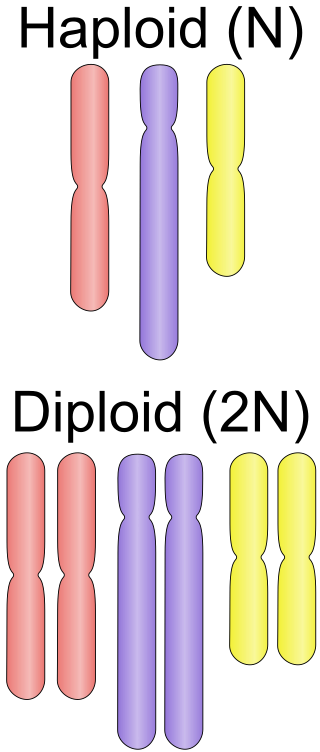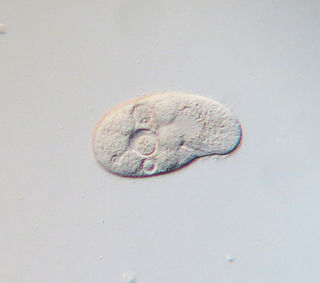
Ploidy is the number of complete sets of chromosomes in a cell, and hence the number of possible alleles for autosomal and pseudoautosomal genes. Sets of chromosomes refer to the number of maternal and paternal chromosome copies, respectively, in each homologous chromosome pair, which chromosomes naturally exist as. Somatic cells, tissues, and individual organisms can be described according to the number of sets of chromosomes present : monoploid, diploid, triploid, tetraploid, pentaploid, hexaploid, heptaploid or septaploid, etc. The generic term polyploid is often used to describe cells with three or more sets of chromosomes.

Tetrahymena, a unicellular eukaryote, is a genus of free-living ciliates. The genus Tetrahymena is the most widely studied member of its phylum. It can produce, store and react with different types of hormones. Tetrahymena cells can recognize both related and hostile cells.
In cellular biology, a somatic cell, or vegetal cell, is any biological cell forming the body of a multicellular organism other than a gamete, germ cell, gametocyte or undifferentiated stem cell. Somatic cells compose the body of an organism and divide through mitosis.
Genetics, a discipline of biology, is the science of heredity and variation in living organisms.
Tracy Morton Sonneborn was an American biologist. His life's study was ciliated protozoa of the group Paramecium.
A macronucleus is the larger type of nucleus in ciliates. Macronuclei are polyploid and undergo direct division without mitosis. It controls the non-reproductive cell functions, such as metabolism. During conjugation, the macronucleus disintegrates, and a new one is formed by karyogamy of the micronuclei.

Nuclear dimorphism is a term referred to the special characteristic of having two different kinds of nuclei in a cell. There are many differences between the types of nuclei. This feature is observed in protozoan ciliates, like Tetrahymena, and some foraminifera. Ciliates contain two nucleus types: a macronucleus that is primarily used to control metabolism, and a micronucleus which performs reproductive functions and generates the macronucleus. The compositions of the nuclear pore complexes help determine the properties of the macronucleus and micronucleus. Nuclear dimorphism is subject to complex epigenetic controls. Nuclear dimorphism is continuously being studied to understand exactly how the mechanism works and how it is beneficial to cells. Learning about nuclear dimorphism is beneficial to understanding old eukaryotic mechanisms that have been preserved within these unicellular organisms but did not evolve into multicellular eukaryotes.
Microbial genetics is a subject area within microbiology and genetic engineering. Microbial genetics studies microorganisms for different purposes. The microorganisms that are observed are bacteria, and archaea. Some fungi and protozoa are also subjects used to study in this field. The studies of microorganisms involve studies of genotype and expression system. Genotypes are the inherited compositions of an organism. Genetic Engineering is a field of work and study within microbial genetics. The usage of recombinant DNA technology is a process of this work. The process involves creating recombinant DNA molecules through manipulating a DNA sequence. That DNA created is then in contact with a host organism. Cloning is also an example of genetic engineering.

Paramecium caudatum is a species of unicellular protist in the phylum Ciliophora. They can reach 0.33 mm in length and are covered with minute hair-like organelles called cilia. The cilia are used in locomotion and feeding. The species is very common, and widespread in marine, brackish and freshwater environments.
The following outline is provided as an overview of and topical guide to genetics:
Karyorelictea is a class of ciliates in the subphylum Postciliodesmatophora. Most species are members of the microbenthos community, that is, microscopic organisms found in the marine interstitial habitat, though one genus, Loxodes, is found in freshwater.

The ciliates are a group of alveolates characterized by the presence of hair-like organelles called cilia, which are identical in structure to eukaryotic flagella, but are in general shorter and present in much larger numbers, with a different undulating pattern than flagella. Cilia occur in all members of the group and are variously used in swimming, crawling, attachment, feeding, and sensation.
Amitosis, also known as karyostenotic, direct cell division, or binary fission, represents a mode of asexual cell division predominantly observed in prokaryotes. This process is distinct from other cell division mechanisms such as mitosis and meiosis, primarily because it bypasses the complexities associated with the mitotic apparatus, such as spindle formation. Additionally, amitosis does not involve the condensation of chromatin into distinct chromosomes before the division of the cell occurs, simplifying the process of cellular replication.

Sterkiella histriomuscorum, formerly Oxytricha trifallax, is a ciliate species in the genus Sterkiella, known for its highly fragmented genomes which have been used as a model for ciliate genetics.

Colpidium colpoda are free-living ciliates commonly found in many freshwater environments including streams, rivers, lakes and ponds across the world. Colpidium colpoda is also frequently found inhabiting wastewater treatment plants. This species is used as an indicator of water quality and waste treatment plant performance.
Autogamy or self-fertilization refers to the fusion of two gametes that come from one individual. Autogamy is predominantly observed in the form of self-pollination, a reproductive mechanism employed by many flowering plants. However, species of protists have also been observed using autogamy as a means of reproduction. Flowering plants engage in autogamy regularly, while the protists that engage in autogamy only do so in stressful environments.
Gene amplification in Paramecium tetraurelia is an example of gene amplification that has occurred in the unicellular organism Paramecium tetraurelia.
The genome of most cells of eukaryotes remains mainly constant during life. However, there are cases of genome being altered in specific cells or in different life cycle stages during development. For example, not every human cell has the same genetic content as red blood cells which are devoid of nucleus. One of the best known groups in respect of changes in somatic genome are ciliates. The process resulting in a variation of somatic genome that differs from germline genome is called somatic genome processing.
Diploidization is the process of converting a polyploid genome back into a diploid one. Polyploidy is a product of whole genome duplication (WGD) and is followed by diploidization as a result of genome shock. The plant kingdom has undergone multiple events of polyploidization followed by diploidization in both ancient and recent lineages. It has also been hypothesized that vertebrate genomes have gone through two rounds of paleopolyploidy. The mechanisms of diploidization are poorly understood but patterns of chromosomal loss and evolution of novel genes are observed in the process.
This glossary of cellular and molecular biology is a list of definitions of terms and concepts commonly used in the study of cell biology, molecular biology, and related disciplines, including genetics, biochemistry, and microbiology. It is split across two articles:







